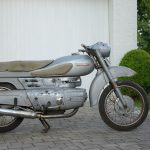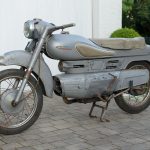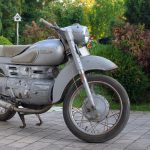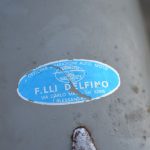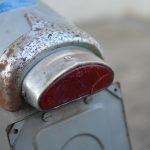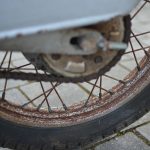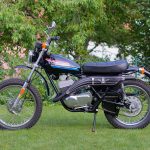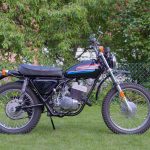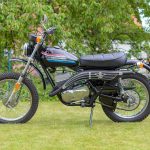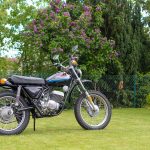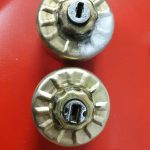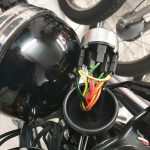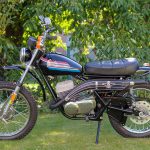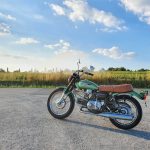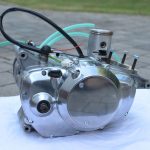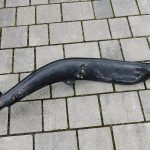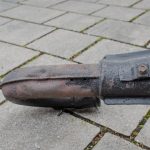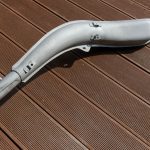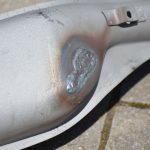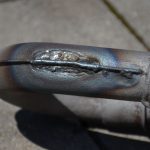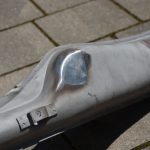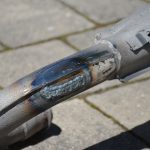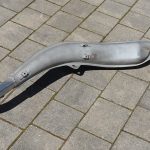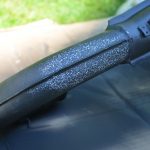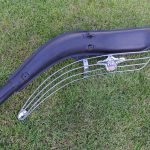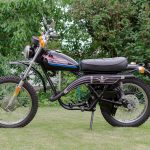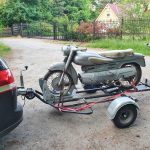
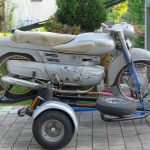
Totally unexpected I have a new Aermacchi restoration project! Accidentally I saw a sales ad for an Aermacchi Chimera which went online just five minutes before I discoverd it and the bike was also located in Germany. This alone does not happen very often, but the price was good as well. I called the seller then everything happend very quickly. Two days later I was driving 500 kilometers north through Germany to get the bike and instantly another 500 kilometers back with the Chimera on the trailer.
What I do know so far: The bike was running until 1986 in Italy. It has 31.000 kilometers on the odometer and was imported to Germany in 1989. Obivsously it was kept in private motorcycle collection since then.
This is a 250cc Chimera. The exact model year is unclear at the moment The decals suggest that it is a model between May 1960 and 1963 as it already reads “Aermacchi Harley-Davidson. According to A.R.S.I.M.A the bike is in an overall original and complete condition and the grey color was experimental by factroy to show dealers new color options”. I am very happy about the condition, even both steering lock keys are there. I do not know if the engine might work, but the bike shifts and the piston is free. Engine and frame VIN are original and matching. I got an import certificate with the bike and a bill of sale.
What makes the Chimera special?
The Chimera is the ancestor of all the Aermacchi four-stroke bikes. The engine was developed especially for the Chimera by engineer Alfredo Bianchi. This new OHV motor with almost horizontal Cylinder was also used in later Aermacchi 175cc and 250cc models like Ala Rossa and Ala Verde and it was also the Basis for some sucessful Aermacchi racing bikes like the Ala d’Oro. The engine was later redeveloped as 350cc motor and in 1973 it got equipped with an electric-starter-motor until model year 1974 when AMF Harley-Davidson decided to stop the production of the italian four-stroke bikes in 1973.
Designer Mario Revelli di Beaumont was contracted in 1956 by Aermacchi to design this new four-stroke motorcycle. He was an experienced designer and also a motorcycle race driver who was already involved in designing some famous Fiat cars. In the 1930 he also worked for Pininfarina. Revelli got free hands designing the Chimera. He decided for the futuristic enclosed engine housing in a “turbine desgin” and a uncommen gas tank which is one piece together with the rear fender to show Aermacchis ancestry as aircraft maker. The bike was unveiled at the milan motorcycle fair in Dezember 1956.
The Chimera is also one of the first motorcycles in the world where allen screws had been used. Parts of the body are aluminum cast and fit very precisely to avoid vibration noises. The engine side-covers themselves are part of the Chimera line and and made to fit perfectly into the design. The bike is as well equipped with a telescopic Upside-Down front fork and a monoshock rear suspension to not disturb the elegant linie of the bike.
Beside all the effort and money that was put into the project the Chimera didn’t sell well. Aermacchi tried to boost the sales by upgrading the bike from 175cc to 250cc in 1958, but this did not bring the success they had hoped for. The production of the Chimera ended in 1964 with only 119 documented 175cc bikes and another 177 Chimeras with 250cc bore. However some more bikes had obvisouly been built, but there is no documentation about it today.
